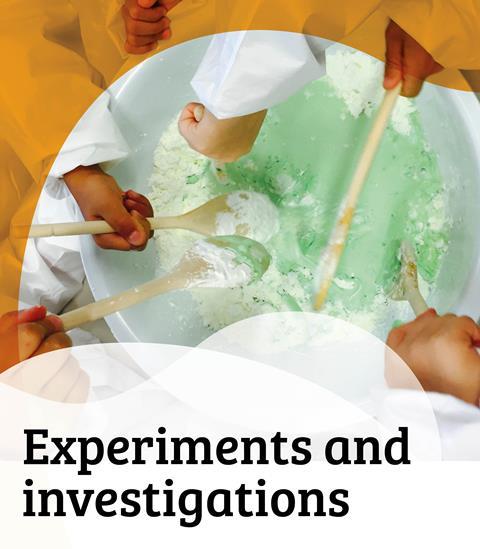In this practical, students predict and observe what happens when water and alcohol, and water and oil are mixed.
Student Sheet
In this practical I will be:
- Predicting what happens when alcohol and oil are added to water.
- Carrying out the practical, making careful observations of what happens when the liquids are mixed.
- Evaluating my original prediction- how was what happened similar or different from what I thought would happen?
Introduction:
You are a well-known and highly respected science-artist in ancient Egypt, and you have just been asked to create a new painting on a temple wall.
Before you start, you have decided to clear up your workshop so you have room to work. Whilst doing so, you poured liquids from several jars together, which you can then pour away…but then you notice something interesting about the mixture.
Like all good scientist-artists, you decide to investigate further…
Equipment:
- 2 eye droppers (or disposable plastic pipettes)
- 2 beakers (100 cm3)
- 100 cm3 water
- 10 cm3 ethanol - Highly flammable and harmful
- 10 cm3 olive oil (or any cooking oil)
- 1 measuring cylinder (100 cm3)
Method:
- Put around 50 cm3 of water into a beaker.
- Use an eye dropper (or plastic pipette) to take up a small quantity (approx. 2 cm3) of the alcohol.
- Place the open end of the eye dropper (plastic pipette) about 0.5 cm below the surface of the water in the beaker.
- Very gently squeeze some of the alcohol into the water and watch carefully what happens.
- Record what you see. Draw a picture, take a photograph or write down what you see.
- Now repeat steps 1–5 but this time use oil not the alcohol.
- Does the same thing happen?
- Now repeat steps 1–5 but this time use water, not the alcohol.
- Does the same thing happen as happened with the alcohol?
- Does the same thing happen as happened with the oil?
- Why do you think there is a difference and what do think is happening?
Theory:
The chemistry of water mixing with other liquids, like alcohol and oil, is really quite complex. A simple explanation is that water molecules and alcohol molecules attract each other. Therefore, when alcohol is added to water, the molecules are attracted to each other and a solution of alcohol in water forms.
The opposite happens with oil and water. The molecules of oil push away from the water molecules. The oil molecules pull towards each other. Because the water is pressing on the oil molecules the oil forms into beads and because they are lighter they float to the surface. On the surface the oil flattens out to form a layer.
Teacher and Technician Sheet
In this practical students will:
- Make predictions and explain their reasoning.
- Make careful observations of the experiment’s results.
- Evaluate their original predictions, using the results of the experiments.
Introduction for teachers:
Children are often fascinated by the way substances mix. This investigation is about observation. It starts with some predictions or guesses about what might happen when water, alcohol and oil are placed into each other. The questions are discussion points and they are best used with a whole class discussion.
- What do you think will happen if I mix these two liquids together?
- Will they form layers or will they mix?
- Will one float on the other? If so which one will be on top?
Going further:
For older primary pupils they could move on to ‘Making water drop art’ or ‘Making an oil/ water emulsion’.
Curriculum range:
Lower primary age but can be used with younger secondary age students to investigate materials: it links with:
- reporting on findings from enquiries, including oral and written explanations, displays or presentations of results and conclusions;
- using straightforward scientific evidence to answer questions or to support their findings;
- compare and group together everyday materials on the basis of their properties;
- know that some materials will mix, while others will not;
- build a more systematic understanding of materials by exploring and comparing the properties of a broad range of materials.
Hazard warnings:
Care needs to be taken with the alcohol since it is inflammable. It may be better if it is dispensed by the teacher where behaviour might be an issue.
Ethanol (IDA) is flammable and harmful. It is suitable for year 7 and upwards to use but may not be suitable for lower primary students.
Equipment:
Per group
- 2 eye droppers (or disposable plastic pipettes)
- 2 beakers (100 cm3)
- 100 cm3 water
- 10 cm3 ethanol
- 10 cm3 olive oil (or any cooking oil)
- 1 measuring cylinder (100 cm3)
Technical notes:
Other oils can be used with similar results.
Results:
Students should be able to observe the results easily. They should be able to notice that the alcohol is visible as it mixes into the water. After a short while there is no difference and the water looks the same as when it started.
Students should notice that the oil does not mix into the water. It sits in a layer on the top of the water.
Students should notice that the water disturbs the water in the beaker and the water level rises, but there is nothing other than the surface disturbance visible unlike the alcohol and the oil.
Downloads
Oil and water mix: student sheet
Experiment | PDF, Size 0.23 mbOil and water mix: teacher sheet
Experiment | PDF, Size 82.07 kb











